
Functions. Just hearing the word is enough to send some students running for the hills. But never fear! Though function problems are considered some of the more challenging questions on the ACT, this is only due to the fact that most of you will be far more used to dealing with other math topics (like fractions, exponents, or circles) than you are functions.
On the ACT, question difficulty is categorized by how familiar you are likely to be with any given question, and the only way to combat this challenge is to practice and get used to dealing with questions that are a little less familiar to you. You will generally see 3-4 function questions on any given ACT, so for those of you who are not yet comfortable with functions (or just want a tune up), this guide is for you.
This will be your complete guide to ACT functions. We'll walk you through exactly what functions mean, how to use, manipulate, and identify them, and exactly what kind of function problems you'll see on the ACT.
What Are Functions and How Do They Work?
Functions act as a way to describe the relationship between inputs and outputs. They can be in the form of equations, graphs, or tables, but they will always describe this input-output relationship.
It may help to think of functions like an assembly line or like a recipe—input eggs, veggies, and cheese, and the output is an omelette.
Most often you'll see functions written as $f(x) = \an \equation$. The equation of the function can be as complex as a multivariable expression or as simple as an integer.
Examples of functions:
$f(x) = 14$
$f(x) = 2x + 10$
$f(x) = x^2 - 6x + 9$
Functions can always be graphed and different kinds of functions will produce different kinds of graphs. On a standard coordinate graph with axes of $x$ and $y$, the input of the graph will be the $x$ value and the output will be the $y$ value.
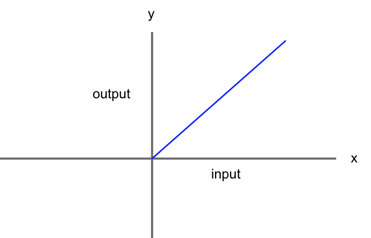
Each input ($\bi x$ value) can produce only one output, but one output can have multiple inputs. In other words, multiple inputs may produce the same output.
One way to remember this is that you can have "many to one" (many inputs to one output), but NOT "one to many" (one input to many outputs).
This means that a function graph can have potentially many $\bi x$-intercepts, but only one $\bi y$-intercept. (Why? Because when the input is $x = 0$, there can only be one output, or $y$ value.)
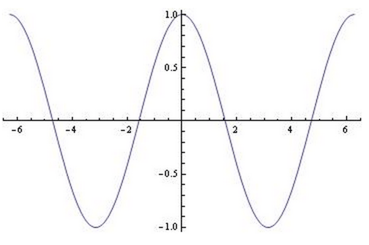
A function with multiple $x$-intercepts
You can always test whether a graph is a function graph using this understanding of inputs to outputs by using the "vertical line test." A function will never hit more than one point on any vertical line.
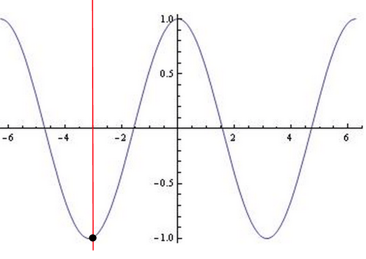
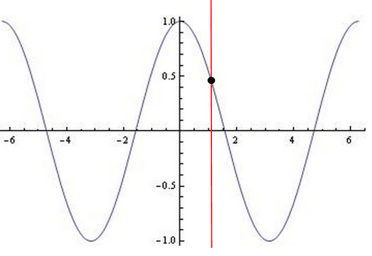
The vertical line test applies to every type of function, no matter how "strange" looking.
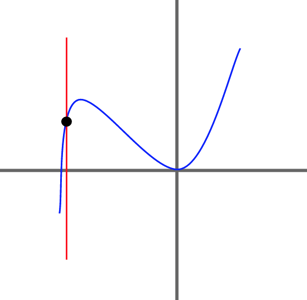
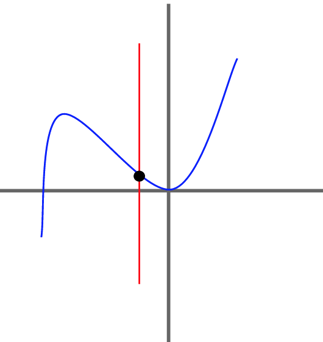
Even "strange-looking" functions will adhere to the vertical line test.
But any graph that fails the vertical line test (by intersecting with the vertical line more than once) is automatically NOT a function.

This graph fails the vertical line test, which means it is NOT a function.

If necessary, you can always spot a genuine function from a non-function by using the vertical line test.
Function Terms and Definitions
Now that we've seen what functions do, let's talk about the pieces of a function.
Functions will be presented to you either by their equations, their tables, or by their graph (called the "graph of the function"). Let's look at a sample function equation and break it down into its components.
An example of a function:
$f(x) = x^2 + 12$
$f$ is the name of the function
(Note: we can call our function other names than $f$. This particular function is called $f$, but you may see functions written as $h(x)$, $g(x)$, $r(x)$, or anything else.)
$(x)$ is the input
(Note: in this case our input is called $x$, but, just like with the name of our function, we can call our input anything. $f(q)$ or $f(\bananas)$ are both functions with the inputs of $q$ and $\bananas$, respectively.)
$x^2 + 5$ is the equation that gives us the output once we plug in the input value of $x$
An ordered pair is the coupling of a particular input with its output for any given function. So for the function $f(x) = x - 6$, with an input of 2, we can have an ordered pair of:
$f(x) = x - 6$
$f(2) = 2 - 6$
$f(2) = -4$
So our ordered pair is $(2, -4)$.
(Again, our input value will represent our $x$ value and the result of the equation once that input value has been processed will be our $y$ value.)
Ordered pairs also act as coordinates, so we can use them to graph our function graph.

Now that we have all of our function pieces and definitions, let's look at how they work together.
Different Types of Functions
We saw before that functions can have all sorts of different equations for their output, which will change the shape of their corresponding graphs. Let's look at each type of equation and its graph.
Linear Functions
A linear function makes a graph of a straight line. The equation of a linear function can either be a simple number (e.g. ,$f(x) = 4$) or will have a variable that is NOT raised to a power higher than 1 (e.g., $f(x) = 3x + 3$).

Why can the variable NOT be raised to a power higher than 1? Because $x^2$ can give you a single output ($y$-value) for two different inputs of $x$. For example, $-4^2$ and $4^2$ both equal 16, which means the graph cannot be a straight line. (We will look into this further in the next section on quadratic functions.)
The standard equation of a line is:
$y = mx + b$
$\bi m$ is the slope of the line.
$\bi b$ is the $\bi y$-intercept.
(For more on lines and slopes, check out our guide to ACT lines and slopes!)
Examples of linear functions:
$f(x) = x - 24$
$f(x) = 4$
$f(x) = 2x + 35$
Quadratic Functions
A quadratic function makes a graph of a parabola, which is a "horseshoe" type graph that curves to open either up or down. It also means that our output variable will always be squared.
The reason our variable must be squared (not cubed, not taken to the power of 1, etc.) is for the same reason that a linear function cannot be squared—because two input values can be squared to produce the same output (e.g. $5^2$ and $-5^2$ both equal 25).
This gives us our curve.
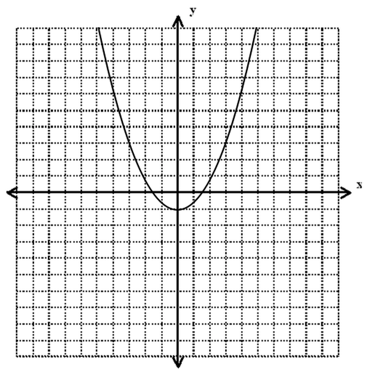
(Note: a parabola cannot open side to side because it would have to cross the $y$-axis more than once. This, we've already established, would mean it would fail the vertical line test and therefore NOT be a function.)
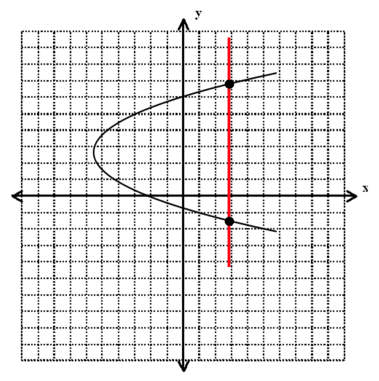
This is NOT a quadratic equation, as it fails the vertical line test.
A quadratic function is often written as:
$f(x) = ax^2 + bx + c$
The $\bi a$ value tells us how the parabola is shaped and the direction in which it opens.
A positive $\bi a$ gives us a parabola that opens upwards.
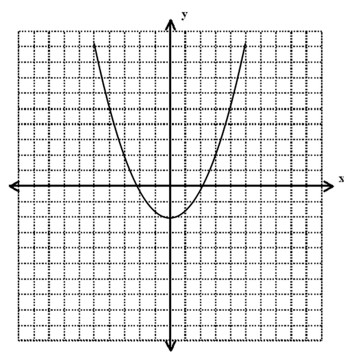
A negative $\bi a$ gives us a parabola that opens downwards.
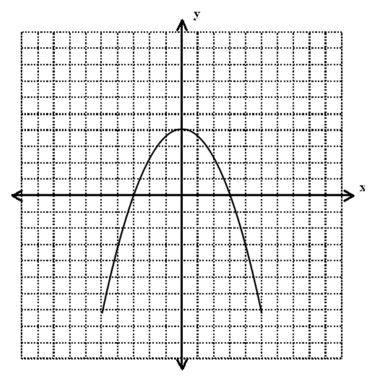
A large $\bi a$ value gives us a skinny parabola.
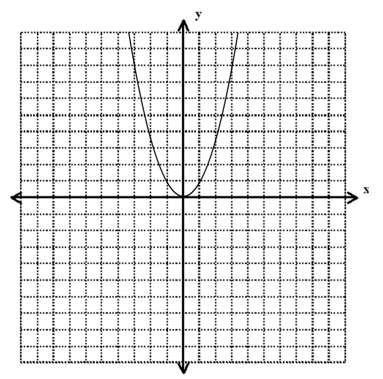
A small $\bi a$ value gives us a wide parabola.
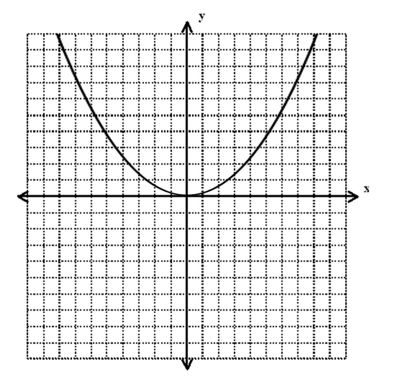
The $\bi b$ value tells us where the vertex of the parabola is, left or right of the origin.
A positive $\bi b$ puts the vertex of the parabola left of the origin.

A negative $\bi b$ puts the vertex of the parabola right of the origin.
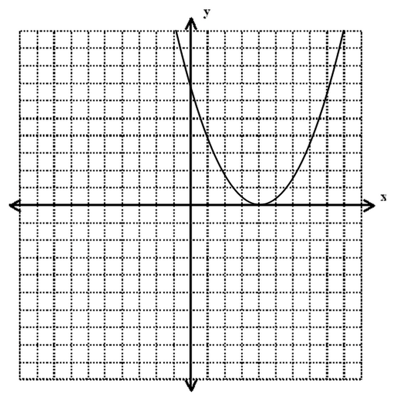
The $\bi c$ value gives us the $y$-intercept of the parabola.

(Note: when $b = 0$, the y-intercept will also be the location of the vertex of the parabola.)
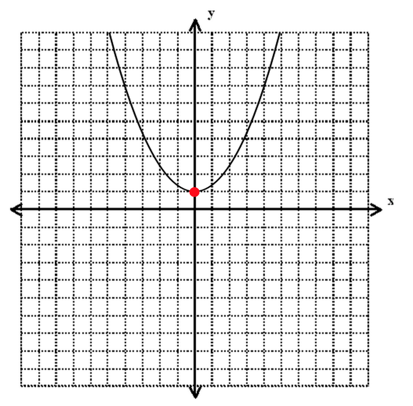

Don't stress if this feels like a lot of information for the moment—a little practice and organization will soon have you solving your function questions, no problem.
Typical Function Problems
ACT function problems will always test you on whether you properly understand the relationship between inputs and outputs. These questions will generally fall into four question types:
#1: Functions with given equations
#2: Nested functions
#3: Functions with graphs
#4: Functions with tables
There may be some overlap between the three categories, but these are the main themes you'll be tested on when it comes to functions. Let's look at some real ACT math examples of each type.
Function Equations
A function equation problem will give you a function in equation form and then ask you to use one or more inputs to find the output (or elements of the output).
In order to find a particular output, we must plug in our given input for $x$ into our equation. This will give us our final output, once we then solve the equation.
So if we want to find $f(5)$ for the equation $f(x) = x + 7$, we would plug in 5 for $x$.
$f(x) = x + 7$
$f(5) = 5 + 7$
$f(5) = 12$
So, when our input ($x$) is 5, our output ($y$) is 12.
Now let's look at a real ACT example of this type:
For the function $h(x)=4x^2-5x$, what is the value of $h(-3)$?
A. -93
B. -9
C. 21
D. 51
E. 159
Though this function is named $h$ (instead of the usual $f$), the principles are exactly the same—we must plug in our input value of -3 in order to find our output.
So let us plug in -3 for our $x$.
$h(x) = 4x^2 - 5x$
$h(-3) = 4(-3)^2 - 5(-3)$
$h(-3) = 4(9) + 15$
$h(-3) = 36 + 15$
$h(-3) = 51$
Our final answer is D, 51.
Nested Functions
The second type of function problem you might encounter on the ACT is called a "nested" function. Basically, this is an equation within an equation.
In order to solve these types of questions, think of them in terms of your order of operations. You must always work from the inside out, so first find the output for your innermost function.
Once you've found the output of your innermost function, you can use that result as the input of the outer function.
Let's look at this in action to make more sense of this process.
Given $f(x)=4x+1$ and $g(x)=x^2-2$, which of the following is an expression for $f(g(x))$?
F. $-x^2+4x+1$
G. $x^2+4x-1$
H. $4x^2-7$
J. $4x^2-1$
K. $16x^2+8x-1$
Because $g(x)$ is nested the deepest, we must use its output as the value of our input for $f(g(x))$.
Essentially, instead of a number for $x$ in $f(x)$, we are given another equation, $g(x)$. And yet, the principle behind solving the function is exactly the same as we did above in our function equations section—replace whatever input we have with the variable in the output equation.
So, to start with, we have two function equations.
$g(x) = x^2 - 2$
$f(x) = 4x + 1$
Now let us replace $x$ in our $f(x)$ equation with the full equation of $g(x)$.
$f(x) = 4x + 1$
$f(g(x)) = 4(x^2 - 2) + 1$
$f(g(x)) = 4x^2 - 8 + 1$
$f(g(x)) = 4x^2 - 7$
Our final answer is H, $f(g(x)) = 4x^2 - 7$
Function Graphs
A function graph question will provide you with an already graphed function and ask you any number of questions about it.
These questions will generally ask you to identify specific elements of the graph or have you find the equation of the function from the graph.
So long as you understand that $x$ is your input and your equation is your output $y$, then these types of questions will not be as tricky as they appear.
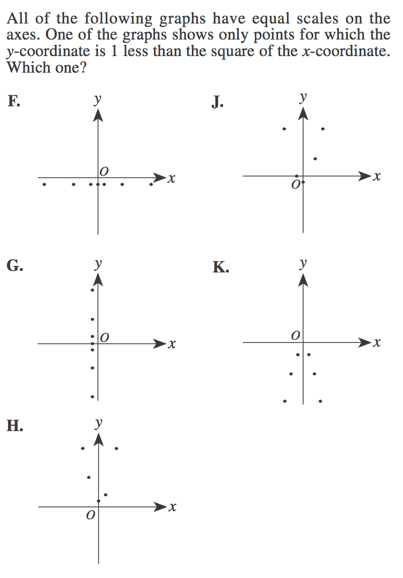
This question relies on us knowing how the formula for a quadratic equation works. If you remember from earlier, a quadratic equation requires a square power and will form a parabola.
We are told that the $x$-coordinate value will be squared, so we know for a fact that this graph will indeed form a parabola and be a quadratic equation. This means we can eliminate answer choices F and G, as they are straight lines, not parabolas.
Now, we are told that the $y$-coordinate value is 1 less than the $x$-coordinate square. We know that our standard quadratic formula equation is:
$ax^2 + bx + c$
$c$ gives us our $y$-intercept and, in this equation, we are told that it will be -1.
This means we can eliminate answer choice H, as the $y$-intercept is not at -1.
Finally, we are told that the points on our graph are the ONLY place where the $y$-coordinate is less than the $x$-coordinate. This means that our graph must open upwards, which means we can eliminate answer choice K.
Our final answer is, therefore, J.
Function Tables
The last way you may see a function is in its table.
Here, you will be given a table of values both for the input and the output and then asked to either find the equation of the function or the graph of the function.
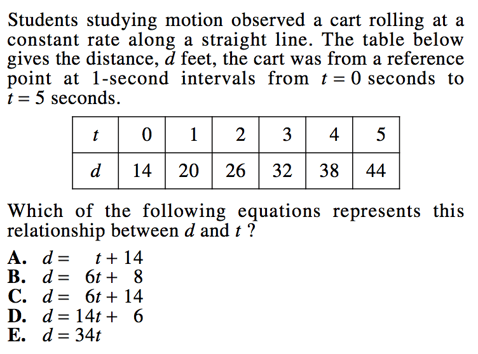
(Note: instead of using $x$ as our input, this problem has us use $t$. If you become very used to using $f(x)$, this may seem disorienting, so you can always rewrite the problem using $x$ in place of $t$. In this case, we will continue to use $t$, just so that we can keep the problem organized on the page.)
First, let us find the $y$-intercept.
The $y$-intercept is the point at which $x = 0$, so we can see that we are already given this with the first set of numbers in the table. When $t = 0$, $d$ (otherwise thought of as $f(t)$) equals 14.)
Our $y$-intercept is therefore 14, which means that the equation of our line will look like:
$y = mx + 14$
We can automatically eliminate answer choices B, D, and E, since their $y$-intercepts are not at 14.
Now, let us use the strategy of plugging in answers to make our lives simpler. This way, we don't have to actually find the equation on our own—we can simply test which answer choices match the inputs and outputs we are given in our table.
Our answer choices are between A and C, so let us first test A with the second ordered pair.
Our potential equation is:
$d = t +14$ (or, in other words: $f(t) = t + 14$)
And our ordered pair is:
$(1, 20)$
So let us put them together.
$f(t) = t + 14$
$f(1) = 1 + 14$
$f(1) = 15$
This is incorrect, as it would mean that our output is 15 when our input is 1, and yet the ordered pair says that our output will be 20 when our input is 1.
Answer choice A is incorrect.
By process of elimination, let us try answer choice C.
Our potential equation is:
$d = 6t + 14$ (or, in other words: $f(t) = 6t + 14$)
And our ordered pair is again:
$(1, 20)$
So let us put them together.
$f(t) = 6t + 14$
$f(1) = 6(1) + 14$
$f(1) = 6 + 14$
$f(1) = 20$
This matches the input and output we are given in our ordered pair. Answer choice C is correct.
(Note: it is generally a good idea to test more than one ordered pair, as two equations may occasionally get the same ordered pair. In this case, we stopped here as there were no other answer choices that could possibly match).
Our final answer is C, $d = 6t + 14$.
 Now that we've seen our definitions, let's talk function strategy.
Now that we've seen our definitions, let's talk function strategy.
How to Solve a Function Problem
Now that you've seen all the different kinds of function problems in action, let's look at some tips and strategies for solving function problems.
For clarity, we've split these strategies into multiple sections—tips for all function problems and tips for function problems by type. So let's look at each strategy.
For All Function Problems
#1: Keep careful track of all your pieces and write everything down
Though it may seem obvious, in the heat of the moment it can be far too easy to confuse your negatives and positives or misplace which piece of your function (or graph or table) is your input and which is your output. Parenthesis are crucial.
The creators of the ACT know how easy it is to get pieces of your function equations confused and mixed around (especially when your input is also an equation), so keep a sharp eye on all your moving pieces and don't try to do function problems in your head.
#2: Use PIA and PIN as necessary
As we saw in our function table problem above, it can save a good deal of effort and energy to use the strategy of plugging in answers. You can also use the technique of plugging in your own numbers to test out points on function graphs, work with any variable function equation, or work with nested functions with variables.
For instance, let's look at our earlier nested function problem using PIN. (Remember—most any time a problem involves variables, you can use PIN).
Given $f(x)=4x+1$ and $g(x)=x^2$, which of the following for $f(g(x))$?
F. $-x^2 +4x+1$
G. $x^2+4x-1$
H. $4x^2-7$
J. $4x^2-1$
K. $16x^2+8x-1$
If we remember how nested functions work (that we always work inside out), then we can plug in our own number for $x$ in the function $g(x)$. That way, we won't have to work with variables and can use real numbers instead.
So let us say that the $x$ is the $g(x)$ function is 3. (Why 3? Why not!)
$g(x) = x^2 - 2$
$g(3) = (3)^2 - 2$
$g(3) = 9 - 2$
$g(3) = 7$
Now, let us plug this number as the value for our $g(x)$ function into our nested function $f(g(x))$.
$f(x) = 4x + 1$
$f(g(3)) = 4(7) + 1$
$f(g(3)) = 28 + 1$
$f(g(3)) = 29$
Finally, let us test our answer choices to see which one matches our found answer of 29.
Let us, as usual, start in the middle with answer choice H.
$4x^2 - 7$
Now, we replace our $x$ value with the $x$ value we chose originally—3.
$4(x)^2 - 7$
$4(3)^2 - 7$
$4(9) - 7$
$36 - 7$
$29$
Success! We have found the answer choice that matches our found answer of 29. (Note: if you use this method on the test, make sure to test out your other answer choices to make sure you do not have any duplicate correct answers. We can skim over our answer options and see that none of them equal 29 after we replace our $x$ with 3.)
Our final answer is H, $4x^2 - 7$
#3: Practice, practice, practice
Finally, the only way to get truly comfortable with any math topic is to practice as many different kinds of questions on that topic as you can. If functions are a weak area for you, then be sure to seek out more practice questions.
For Function Graphs and Tables
#1: Start by finding the $\bi y$-intercept
Generally, the easiest place to begin when working with functions is by finding the $y$-intercept. From there, you can often eliminate several different answer choices that do not match our graph or our equation (as we did in some of the examples above).
The $y$-intercept is almost always the easiest piece to find, so it's always a good place to begin.
#2: Test your equation against multiple ordered pairs
It is always a good idea to find two or more points (ordered pairs) of your functions and test them against a potential function equation. Sometimes one ordered pair works for your graph and a second does not.
You must match the equation to the graph (or the equation to the table) that works for every coordinate point/ordered pair, not just one or two.
For Function Equations and Nested Equations
#1: Always work inside out
Nested functions can look beastly and difficult, but take them piece by piece. Work out the equation in the center and then build outwards slowly, so as not to get any of your variables or equations mixed up.
#2: Remember to FOIL
It is quite common for ACT to make you square an equation. This is because many students get these types of questions wrong and distribute their exponents instead of squaring the entire expression.
If you don't properly FOIL, then you will get these questions wrong. Whenever possible, try not to let yourself lose points due to these kinds of careless errors.

Ready to test your function knowledge?
Test Your Knowledge
Now let's put our function knowledge to the test, using real ACT math problems.
1. A function $f(x)$ is defined as $f(x)=-8x^2$. What is $f(-3)$?
F. -72
G. 72
H. 192
J. -576
K. 576
2.

3. Consider the functions $f(x)=√x$ and $g(x)=7x+b$. In the standard $(x,y)$ coordinate plane, $y=f(g(x))$ passes through $(4,6)$. What is the value of $b$?
A. $8$
B. $-8$
C. $-25$
D. $-26$
E. $4-7√6$
4.
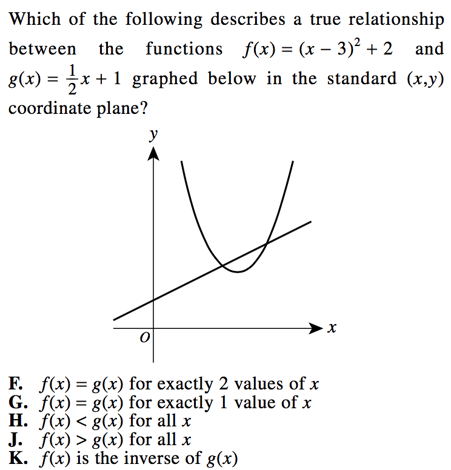
5. A function P is defined as follows:
for $x>0$, $(P(x)=x^5+x^4-36x-36$
for $x<0$, $P(x)=-x^5+x^4+36x-36$
What is the value of $P(-1)$?
A. -70
B. -36
C. 0
D. 36
E. 70
Answers: F, C, A, F, A
Answer Explanations:
1. Here, we have a simple function equation. So let us replace our given input (-3) for our $x$ value in order to find our output.
Note that the reason this problem is tricky is due to the many negative signs and the placement of the square. But so long as we are careful and make sure to keep track of all our pieces, we can solve the problem just fine (without falling for bait answers!).
$f(x) = -8x^2$
$f(-3) = -8(-3)^2$
$f(-3) = -8(9)$
$f(-3) = -72$
Our final answer is F, -72.
2. This question is a function table, so let us remember our function table tips and tricks.
Before we begin, this problem may get slightly confusing, as the labels in the chart are different from that which we normally use. To visualize our data, we are given $x$ as a certain distance that the cart is at any given second, $t$.
This means that our input is $t$ (seconds) and our output is $x$ (distance).
Now that we can see this, let us work through the problem.
First, let us find the $y$-intercept.
Luckily for us, we are given a coordinate pair with $t = 0$, $x = 10$. Because $t$ is serving as our input value (our $x$-coordinate) and $x$ is serving as our output (our y-coordinate), we can see that our $y$-intercept is the point at which $t = 0$.
This means that our $y$-intercept is 10.
Knowing that this is a linear function and the graph of a line is $y = mx + b$, we can eliminate answer choices B, D, and E. None of those give the y-intercept as 10, so none of them can be the correct answer.
Now let us use our PIA strategy to find the equation of the line using our existing coordinate points.
So let us test the point $(2, 18)$ and see which of our remaining equations (answer choice A or answer choice C) gives us these coordinates.
Let us first test answer choice A.
$x = t + 10$
$x = 2 + 10$
$x = 12$
Answer choice A is incorrect. When $t = 2$, $x$ should equal 18.
So let us test answer choice C instead to see if it lines up with our input and output of $(2, 18)$.
$x = 4t + 10$
$x = 4(2) + 10$
$x = 8 +10$
$x = 18$
Success! We have found our proper equation.
Our final answer is C, $x = 4t + 10$
3. This is a nested function problem that requires us to understand that coordinate points can act as inputs and outputs.
So if we solve the nested equation as we normally would (remembering to act inside out), we would see:
$g(x) = 7x + b$
$f(x) = √x$
$f(g(x)) = √{7x + b}$
Remembering that $f(x)$ is essentially another way of saying $y$ (in terms of coordinates), we can say:
$y = √{7x + b}$
Now, let us get rid of the root by squaring both sides (for more on roots and squares, check out our guide to advanced integers). This gives us:
$y^2 = 7x + b$
We know that the function passes through the coordinate point $(4, 6)$, which means we can replace the x and y-values with our $x$ and $y$ in the function equation. So:
$y^2 = 7x + b$
$(6)^2 = 7(4) + b$
$36 = 28 + b$
$8 = b$
Our final answer is A, $b = 8$.
4. In this type of graph question, we are being asked to identify how the two graphs interact. Even without knowing their equations, we can understand—just through the diagram—a good deal of information about our two functions.
In this case, we can see that the two functions intersect at exactly two points. This means that they are equal at exactly two values of $x$.
So answer choice F is correct.
But before we select answer choice F, let us also take the time to eliminate our other answer options.
We know that answer choice G is incorrect, because we have already established that the two graphs intersect at two points and so have two values of $x$ at which they are equal, not 1.
Answer choices H and J are both wrong, because there are x-coordinate points at which the graph $f(x)$ is higher (larger) than that of $g(x)$ and $x$-coordinate points where $f(x)$ is smaller. Neither function is larger (or smaller) at all points of $x$ than the other function.
And finally, answer choice K is also incorrect, as these are two different functions—quadratic and linear—not inverse functions. An inverse function would produce the same type of graph, just inverted.
We know our original answer choice is correct and we have successfully eliminated the others.
Our final answer is F.
5. This is a function that has two different equations depending on our input value. So we must first determine which equation we are using in order to find the output to our particular input.
We are given that our input ($x$) is -1. We also know that we must use the second function equation for any $x$ that is less than 0.
This means we must use the second function equation, $p(x) = -x^5 + x^4 + 36x - 36$
So now we just plug in our input value of -1 (being very careful about all of our negative signs).
$p(x) = -x^5 + x^4 + 36x - 36$
$p(-1) = -(-1)^5 + (-1)^4 + 36(-1) - 36$
$p(-1) = -(-1) + (1) - 36 - 36$
$p(-1) = 1 + 1 - 36 - 36$
$p(-1) = 2 - 72$
$p(-1) = -70$
Our final answer is A, -70.

Congrats! You've mastered ACT functions!
The Take Aways
Even though there are many different ways you can be presented with a function problem, the core principles are always the same. No matter the equation or the graph, functions are always looking at inputs and outputs and the relationship between the two.
So long as you remember your function definitions (and the corresponding graph shapes) and keep a clear head, and you'll see that functions are not as difficult as they may have once appeared.
What's Next?
You've taken on (and conquered) one of the most difficult math topics on the ACT (go you!), but there are many more topics to cover. Next, take a gander at all the math topics on the test and then bulk up on any topic with which you feel rusty. Need to brush up how to complete the square? On your rules of roots and exponents? How about your triangle rules and problems? All of our ACT math guides come complete with strategies and practice problems for any topic you need.
Feeling overwhelmed? Make sure you take a practice test and then see how your score stacks up so that you can set realistic milestones and goals.
Running out of time on the ACT math section? Check out how to best beat the clock and maximize your score.
Aiming for a perfect score? Our guide to getting a perfect 36 on the ACT math section (written by a perfect-scorer!) will help get you where you need to be.
Want to improve your ACT score by 4 points?
Check out our best-in-class online ACT prep program. We guarantee your money back if you don't improve your ACT score by 4 points or more.
Our program is entirely online, and it customizes what you study to your strengths and weaknesses. If you liked this Math lesson, you'll love our program. Along with more detailed lessons, you'll get thousands of practice problems organized by individual skills so you learn most effectively. We'll also give you a step-by-step program to follow so you'll never be confused about what to study next.
Check out our 5-day free trial:
Have friends who also need help with test prep? Share this article!

Courtney scored in the 99th percentile on the SAT in high school and went on to graduate from Stanford University with a degree in Cultural and Social Anthropology. She is passionate about bringing education and the tools to succeed to students from all backgrounds and walks of life, as she believes open education is one of the great societal equalizers. She has years of tutoring experience and writes creative works in her free time.


































 Holly R.
Holly R.